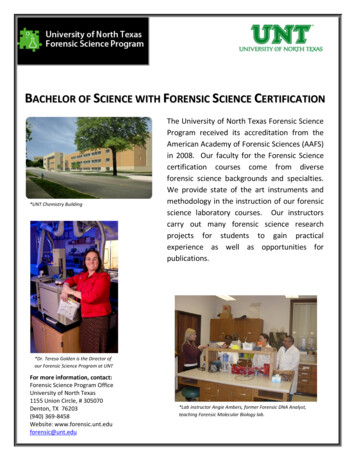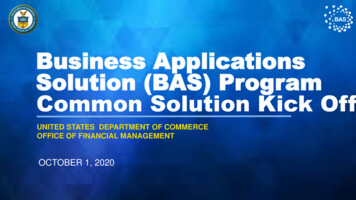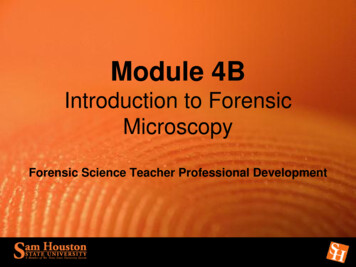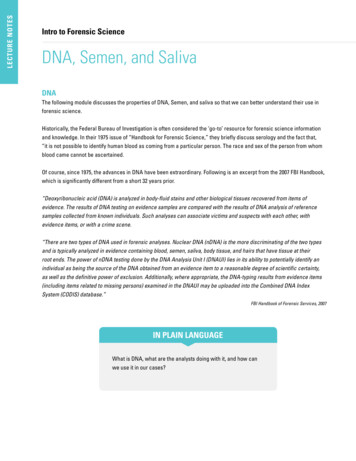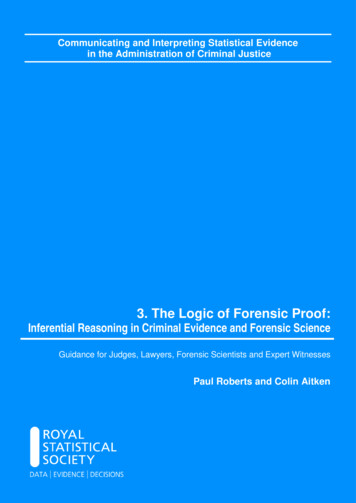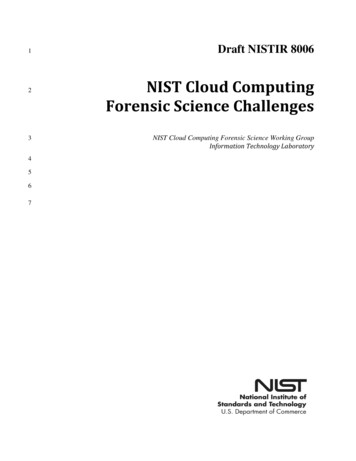
Transcription
1234567Draft NISTIR 8006NIST Cloud ComputingForensic Science ChallengesNIST Cloud Computing Forensic Science Working GroupInformation Technology Laboratory
8Draft NISTIR 800691011NIST Cloud ComputingForensic Science 3233343536373839404142NIST Cloud Computing Forensic Science Working GroupInformation Technology LaboratoryJune 2014U.S. Department of CommercePenny Pritzker, SecretaryNational Institute of Standards and TechnologyWillie E. May, Acting Under Secretary of Commerce for Standards and Technology and Acting Director
43444546National Institute of Standards and Technology Interagency or Internal Report 800651 pages (June 2014)4748495051525354Certain commercial entities, equipment, or materials may be identified in this document in order todescribe an experimental procedure or concept adequately. Such identification is not intended to implyrecommendation or endorsement by NIST, nor is it intended to imply that the entities, materials, orequipment are necessarily the best available for the purpose.There may be references in this publication to other publications currently under development by NISTin accordance with its assigned statutory responsibilities. The information in this publication, includingconcepts and methodologies, may be used by Federal agencies even before the completion of suchcompanion publications. Thus, until each publication is completed, current requirements, guidelines,and procedures, where they exist, remain operative. For planning and transition purposes, Federalagencies may wish to closely follow the development of these new publications by NIST.Organizations are encouraged to review all draft publications during public comment periods andprovide feedback to NIST. All NIST Computer Security Division publications, other than the onesnoted above, are available at ts on this publication may be submitted to: Michaela Iorga60Public comment period: June 23, 2014 through July 21, 201461626364National Institute of Standards and TechnologyAttn: Computer Security Division, Information Technology Laboratory100 Bureau Drive (Mail Stop 8930) Gaithersburg, MD 20899-8930Email: nistir8006@nist.gov65ii
66Reports on Computer Systems Technology67686970717273The Information Technology Laboratory (ITL) at the National Institute of Standards and Technology(NIST) promotes the U.S. economy and public welfare by providing technical leadership for the Nation’smeasurement and standards infrastructure. ITL develops tests, test methods, reference data, proof ofconcept implementations, and technical analyses to advance the development and productive use ofinformation technology. ITL’s responsibilities include the development of management, administrative,technical, and physical standards and guidelines for the cost-effective security and privacy of other thannational security-related information in Federal information systems.7475Abstract76777879808182This document summarizes the research performed by the members of the NIST Cloud ComputingForensic Science Working Group, and aggregates, categorizes and discusses the forensics challengesfaced by experts when responding to incidents that have occurred in a cloud-computing ecosystem. Thechallenges are presented along with the associated literature that references them. The immediate goal ofthe document is to begin a dialogue on forensic science concerns in cloud computing ecosystems. Thelong-term goal of this effort is to gain a deeper understanding of those concerns (challenges) and toidentify technologies and standards that can mitigate them.838485KeywordsDigital forensics; Forensics; Cloud computing forensics; Forensic Science; Forensics challenges86iii
87Acknowledgments8889909192This publication was developed by the NIST Cloud Computing Forensic Science Working Group (NCCFSWG), chaired by Dr. Michaela Iorga and Mr. Eric Simmon. The principal editors of this document areDr. Martin Herman (NIST Senior Adviser) and Dr. Michaela Iorga. The National Institute of Standardsand Technology and the principal editors wish to gratefully acknowledge and thank the members whosededicated efforts contributed significantly to the publication.939495The following list (in alphabetical order by last name) includes contributors, 1 internal reviewers of thedocument and other active members who provided feedback and who have agreed to be acknowledged inthis document.96CONTRIBUTORS (document and challenges ah Dykstra, Ph.D., Department of DefenseLon Gowen, Ph.D., United States Agency for International DevelopmentRobert Jackson, SphereCom Enterprises Inc.Otto Scot Reemelin, CBIZErnesto F. Rojas, Forensic & Security Services Inc.Keyun Ruan, Ph.D., Espion GroupMike Salim, American Data Technology, Inc.Ken E. Stavinoha, Ph.D., Cisco SystemsLaura P. Taylor, Relevant TechnologiesKenneth R. Zatyko, Forensics Technologies & Discovery Services, Ernst & Young LLPINTERNAL REVIEWERS:109110111Nancy M Landreville, University of Maryland University College & BRCTCKristy M. Westphal, Element Payment Services112OTHER ACTIVE MEMBERS:113114115116117Ragib Hasan, Ph.D., Assistant Prof., Dept. of Computer and Information Sciences, Univ. of Alabama atBirminghamMark Potter, Danya InternationalAnthony M Rutkowski, Yaana Technologies118119NOTE: All views expressed in this document by the contributors are their personal opinions and notthose of the organizations with which they are affiliated.1201211221“Contributors” are members of the NIST Cloud Computing Forensic Science WG who dedicated substantial time on a regularbasis to research and development in support of this document.iv
123Executive Summary124125126127The National Institute of Standards and Technology (NIST) has been designated by the Federal ChiefInformation Officer (CIO) to accelerate the federal government’s secure adoption of cloud computing byleading efforts to develop standards and guidelines in close consultation and collaboration with standardsbodies, the private sector, and other stakeholders.128129130131132133134135Consistent with NIST’s mission 2, the NIST Cloud Computing Program (NCCP) has developed “NISTCloud Computing Standards Roadmap” [REF63] as one of many mechanisms in support of the USG’ssecure and effective adoption of the Cloud Computing technology 3 to reduce costs and improve services.Standards are critical to ensure cost-effective and easy migration, to ensure that mission-criticalrequirements can be met, and to reduce the risk that sizable investments may become prematurelytechnologically obsolete. Standards are key elements required to ensure a level playing field in the globalmarketplace 4. The importance of setting standards in close relation with private sector involvement ishighlighted in a memorandum from the White House; M-12-08, 5 dated January 17, 2012.136137138139140141With the rapid adoption of cloud computing technology, a new need has arisen for the application ofdigital forensic science to this domain. The validity and reliability of forensic science is crucial in thisnew context and requires new methodologies for identifying, collecting, preserving, and analyzingevidence in multi-tenant cloud environments that offer rapid provisioning, global elasticity and broadnetwork accessibility. This is necessary to support the U.S. criminal justice and civil litigation systems aswell as to provide capabilities for security incidence response and internal enterprise operations.142143144145146147148149150The NIST Cloud Computing Forensic Science Working Group (NCC FSWG) was established to researchcloud forensic science challenges in the cloud environment and to develop plans for measurements,standards and technology research to mitigate the challenges that cannot be handled with currenttechnology and methods. The NCC FSWG has surveyed existing literature and developed a set ofchallenges related to cloud computing forensics. This document presents those challenges along with theassociated literature. The document also provides a preliminary analysis of these challenges by including(1) the roles of cloud forensics stakeholders, (2) the relationship of each challenge to the five essentialcharacteristics of cloud computing as defined in the Cloud Computing model, and (3) the nine categoriesto which the challenges belong.1512This effort is consistent with the NIST role per the National Technology Transfer and Advancement Act (NTTAA) of 1995,which became law in March 1996.3NIST Definition of Cloud Computing, Special Publication (SP) 800-145 [REF65]: “Cloud computing is a model for enablingubiquitous, convenient, on-demand network access to a shared pool of configurable computing resources (e.g., networks,servers, storage, applications, and services) that can be rapidly provisioned and released with minimal management effort orservice provider interaction.”4This edition of the standards roadmap focuses on USG cloud computing requirements for interoperability, performance,portability, security, and accessibility. It does not preclude the needs to address other essential requirements.5Principles for Federal Engagement in Standards Activities to Address National Priorities, January 17, omb/memoranda/2012/m-12-08.pdfv
152153Table of Contents154EXECUTIVE SUMMARY . V1551561571INTRODUCTION .11.1 DOCUMENT GOALS . 11.2 AUDIENCE. 11581591601612OVERVIEW.22.1 DEFINITION OF CLOUD COMPUTING FORENSIC SCIENCE . 22.2 DEFINING WHAT CONSTITUTES A CHALLENGE FOR CLOUD COMPUTING FORENSICS . 32.3 CLOUD COMPUTING FORENSICS STAKEHOLDERS AND THEIR ROLES . 31621631643CLOUD FORENSICS CHALLENGES.43.1 COLLECTION AND AGGREGATION OF CHALLENGES . 43.2 DATA ANALYSIS . 51651664PRELIMINARY ANALYSIS.84.1 ADDITIONAL OBSERVATIONS . 91675CONCLUSIONS .111686ACRONYMS .121697GLOSSARY .131708REFERENCES .14171ANNEX A - STAKEHOLDERS .19172ANNEX B - CLOUD FORENSICS CHALLENGES .20173174175176177ANNEX C - MIND MAPS .42ANNEX C.1: CATEGORIES AND SUBCATEGORIES . 42ANNEX C.2: PRIMARY CATEGORIES . 43ANNEX C.3: RELATED CATEGORIES . 44178179Table of Figures180181Figure 1: Normalized Formula for Expressing Cloud Computing Forensics Challenges . 5182Figure 2: Mind Map – Categories and Subcategories .42183Figure 3: Mind Map – Primary Categories .43184Figure 4: Mind Map – Related Categories .44185186vi
NIST Cloud Computing Forensic Science Challenges r the past few years, cloud computing has revolutionized the methods by which digital data is stored,processed, and transmitted. With this paradigm shift away from traditional standalone computer devices,workstations and networks to the cloud environment, many technological challenges exist. One of themost daunting new challenges is how to perform digital forensics in the various types of cloud computingenvironments. Cloud computing, in some respects, is similar to prior computing technologies. However,with the advent of advanced hypervisors (which allow virtual machines) and geographical independence(due to networking advancements), challenges with forensics in these arenas, which may crossgeographical boundaries or legal boundaries, become an issue.196197198199200201NIST carries out many research activities related to forensic science. The goals of these activities are toimprove the accuracy, reliability, and scientific validity of forensic science through advances in itsmeasurements and standards infrastructure. As part of these activities, the NIST Cloud ComputingForensic Science Working Group (NCC FSWG) is identifying emerging standards and technologies thatwould help solve “challenges,” that is, the most pressing problems fundamental to carrying out forensicsin a cloud computing environment to lawfully obtain (e.g., via warrant or subpoena) all relevant artifacts.202203204205206207208The cloud exacerbates many technological, organizational, and legal challenges already faced by digitalforensics examiners. Several of these challenges, such as those associated with data replication, locationtransparency, and multi-tenancy are somewhat unique to cloud computing forensics [REF2]. The NCCFSWG collected and aggregated a list of cloud forensics challenges (see Annex B) that are introduced anddiscussed in this document. Future work will involve developing possible technological approaches tomitigate these challenges, and determining gaps in technology and standards needed to address thesechallenges.2091.1210211212This document serves as a basis to begin a dialogue on forensic science concerns in cloud computingecosystems, and serves as a starting point for understanding those concerns (challenges), with the intent tosolve these challenges by identifying technologies and standards to meet those challenges.2131.2214215216217The primary audience for this document includes digital forensics examiners and researchers, cloudsecurity professionals, law-enforcement officers and cloud auditors. However, given the breadth anddepth of this topic, many other stakeholders, such as cloud policy makers, executives, and the general userpopulation of cloud service consumers may also be interested in certain aspects of this document.Document GoalsAudience1
NIST Cloud Computing Forensic Science Challenges (Draft)2182Overview219220221This section discusses the definition of cloud computing forensic science, elaborates on why cloudcomputing challenges traditional digital forensics methods, and describes what constitutes a challenge forcloud forensics.2222.1223224225226227Many experts consider forensic science to be the application of a broad spectrum of sciences andtechnologies to the investigation and establishment of facts of interest in relation to criminal, civil law, orregulatory issues. The rapid advance of cloud services requires the development of better forensic tools tokeep pace. However, the resulting techniques may also be used for purposes outside the scope of law toreconstruct an event that has occurred.228229230Cloud computing forensic science is the application of scientific principles, technological practices andderived and proven methods to reconstruct past cloud computing events through identification, collection,preservation, examination, interpretation and reporting of digital evidence.231232233234235236NIST defines cloud computing (see [REF65]) as “a model for enabling ubiquitous, convenient, ondemand network access to a shared pool of configurable computing resources (e.g., networks, servers,storage, applications, and services) that can be rapidly provisioned and released with minimalmanagement effort or service provider interaction. This cloud model is composed of five essentialcharacteristics, three service models, and four deployment models.” Cloud forensics is a process appliedto an implementation of this model.237238239240241242Ruan, et al. [REF2] proposes a working definition for cloud forensics as the application of digital forensicscience in cloud environments. Technically, it consists of a hybrid forensic approach (e.g., remote, virtual,network, live, large-scale, thin-client, thick-client) towards the generation of digital evidence.Organizationally it involves interactions among cloud actors (i.e., cloud provider, cloud consumer, cloudbroker, cloud carrier, cloud auditor) for the purpose of facilitating both internal and externalinvestigations. Legally it often implies multi-jurisdictional and multi-tenant situations.243244Various process models have been developed for digital forensics, including the following eightdistinctive steps and attributes 2592601. Search authority. In a legal investigation, legal authority is required to conduct a search or seizureof data.2. Chain of custody. In legal contexts, chronological documentation of evidence handling is requiredto avoid allegations of evidence tampering or misconduct.3. Imaging/hashing function. When digital evidence is found, it should be carefully duplicated andthen hashed to validate the integrity of the copy.4. Validated tools. When possible, tools used for forensics should be validated to ensure reliabilityand correctness.5. Analysis. Forensic analysis is the execution of investigative and analytical techniques to examinethe evidence.6. Repeatability and reproducibility (quality assurance). The procedures and conclusions of forensicanalysis should be repeatable and reproducible by the same or other forensic analysts.7. Reporting. The forensic analyst must document his or her analytical procedure and conclusions foruse by others.8. Possible presentation. In some cases, the forensic analyst will present his or her findings andconclusions to a court or other audience.Definition of Cloud Computing Forensic Science2
NIST Cloud Computing Forensic Science Challenges (Draft)261262263264265In order to carry out digital forensic investigations in the cloud, these steps need to be applied or adaptedto the cloud context. Many of them pose significant challenges. This document is focused on the forensicanalysis of artifacts retrieved from a cloud environment. A related discipline, which is not addressed here,is carrying out the forensic process using a cloud environment. This involves using the cloud to performexamination and analysis of digital evidence [REF68].2662.2267268269270There are numerous challenges for the various stakeholders who share an interest in forensic analysis ofcloud computing environments. Challenges to cloud forensics can broadly be categorized into technical,legal, and organizational 6 challenges. Such challenges occur when technical, legal, or organizational tasksbecome impeded or prevent the examination by the digital forensics examiner.271272273274275276277278When comparing cloud forensics challenges to those of traditional digital forensics, we consider cloudforensics challenges to be either unique to the cloud environment, or exacerbated by the cloudenvironment [REF2]. While the goals of first responders and forensic examiners may be the same in thecloud context in comparison to traditional large-scale network forensics, distinctive features of cloudcomputing such as segregation of duties among cloud actors, inability to acquire network logs from theload balancer or routers, multi-tenancy, and rapid elasticity introduce unique scenarios for digitalinvestigations. On the other hand, challenges associated with, for example, virtualization, large-scale dataprocessing, and proliferation of mobile devices and endpoints are exacerbated in the cloud.279280281282Cloud forensics challenges cannot be solved by technology, law, or organizational principles alone. Manyof the challenges need solutions in all three areas. Technical, legal and organizational scholars andpractitioners have begun to discuss these challenges. This report focuses more on the technical challenges,which need to be understood in order to develop technology- and standards-based mitigation approaches.2832.3284285286287288289There are many stakeholders involved in cloud forensics activities, including members of government,industry, and academia. One of the biggest challenges in cloud computing is understanding who holds theresponsibilities for the various tasks involved in managing the cloud. All responsibilities should be clearat the time of contract signing. Forensics is an area that is particularly prone to misunderstandings since itis often not until a forensic investigation is under way that stakeholders start making assertions aboutownership and responsibilities.290291292293294295For the purposes of this document, a list of stakeholders in cloud forensics is presented in Annex A. Thetable in this Annex introduces the stakeholders in the left-most column and provides a description of eachstakeholder in the right-most column. The central columns identify the Cloud Actors as defined in NISTSP 500-292 [REF64]. The roles played by each cloud stakeholder in the cloud ecosystem are identified.The list provided in Annex A is not comprehensive. It was created based on the analysis of the forensicschallenges the authors collected and aggregated as part of this study.Defining What Constitutes a Challenge for Cloud Computing ForensicsCloud computing forensics stakeholders and their roles2966Organizational challenges involve challenges dealing with cloud actors (see Annex A) working together to obtain digitalevidence. The cloud actors include consumer, provider, broker, auditor and carrier [REF2].3
NIST Cloud Computing Forensic Science Challenges (Draft)2973298299This section discusses how the NCC FSWG collected and aggregated the challenges, as well as the stepstaken to perform a preliminary analysis of the challenges.3003.1301302303The first step towards identifying the challenges that cloud forensics practitioners are facing was to studythe available literature and gather available data on this topic. The data was then aggregated in ameaningful way that permits further analysis.304305306307The data was gathered and aggregated as a collective group effort by the active participants of the NCCFSWG. These active participants represent many key cloud ecosystem stakeholders, includinggovernment, private industry, and academia, both domestically and internationally. The methodology forgathering the data was as follows:308309310311 312313314315The data gathered was inserted into a spreadsheet (shown in Annex B) that currently lists 65 challenges,together with challenge descriptions, categories, cloud computing essential characteristics [REF65], andrelevant references. (Note that the last column in the spreadsheet lists references that discuss eachchallenge.)316317318To better assist with a focused discussion and formal analysis of the challenges, a “normalized syntax”was developed with which to express each challenge. This “normalized syntax” is described later in thissection.319320The cloud forensic science challenges were aggregated in a spreadsheet referred to as the “CloudForensics Challenges” spreadsheet. The major objectives of the spreadsheet 36 337To achieve these objectives, we developed a formula for a normalized sentence syntax that allows Cloud Forensics ChallengesCollection and Aggregation of ChallengesPerform a literature search. Most of these sources are listed in the References Section (Section 8).Obtain input from a variety of stakeholders in the group.Have various group discussions among the participants through scheduled conference calls as well asemails.Identify the major challenges in conducting digital forensics procedures where the evidence resides ina cloud computing environment. While there are challenges in conducting any digital forensicsprocedure, the essential characteristics of cloud computing systems enumerated in Section 3.2 providemany challenges that are not encountered, or encountered to a lesser degree, in more traditionalcomputing models.Establish a common vocabulary for communicating challenges between stakeholders. There are manystakeholders in cloud forensics including, but not limited to, cloud Consumers, cloud Providers, firstresponders, forensics examiners, and law enforcement. As a result of this diverse set of stakeholders,a common “language” is needed to allow effective communication of the challenges between thevarious groups.Create an on-going dialogue among stakeholders to define potential technology and standardsmitigation approaches to the forensics challenges faced in the cloud computing environment. Thechallenges identified in the Cloud Forensics Challenges spreadsheet are certainly not comprehensive.As the spreadsheet continues to evolve, the long term objective is to identify potential technology andstandards mitigation approaches and to determine technology and standards gaps to address thechallenges.4
NIST Cloud Computing Forensic Science Challenges (Draft)338339expression of all cloud forensics challenges in a common format. Figure 1 contains the normalizedformula.Normalized challenge [formula]:For an [actor/stakeholder], [action/operation] applicable to[object of this action] is challenging because [reason]340341Figure 1: Normalized Formula for Expressing Cloud Computing Forensics ChallengesThis formula is comprised of four “variables:” 342343344345346347348349350351352353354355356357In Annex B, the normalized description of each challenge is shown in the sixth column.Taken as a whole, the 65 items identified by the Cloud Forensics Challenges spreadsheet represent manyof the major challenges that are being faced in performing digital forensics in the cloud environmentbased on the collective experience of the NCC FSWG. The NCC FSWG hopes that by initiating thisdialogue, the experience of other professionals can be drawn upon to further refine and update thisproduct.3583.2359360361The NCC FSWG has attempted to keep the challenges generic without taking on the multitude ofdifferences in architectures between the many products that proliferate the cloud computing family ofofferings.362363364365To assist in organizing the cloud forensics challenges, each challenge was correlated to one or more of thefive essential characteristics of the cloud computing model as defined in The NIST Definition of CloudComputing [REF65]. These characteristics, which are identified in the second column of the challengesspreadsheet in Annex B, include:366367368369370371372373374375 Actor/Stakeholder – This variable [a noun] identifies the stakeholder(s) who is affected by thechallenge that has been identified. Examples of stakeholders include cloud consumers,investigators, first responders, etc.Action/Operation - This variable [a verb] identifies the activity that the stakeholder would like toperform. Examples of actions include decrypting, imaging, gaining access, etc.Object of This Action – This variable identifies the specific item upon which the action is to beperformed. Examples of objects include data, audit logs, time stamps, evidence, etc.Reason – This variable identifies the primary challenges that the stakeholder faces in order toperform the specified action on the object.Data AnalysisOn-demand self-service - A consumer can unilaterally provision computing capabilities, such asserver time and network storage, as needed automatically without requiring human interaction witheach service provider.Broad network access - Capabilities are available over the network and accessed through standardmechanisms that promote use by heterogeneous thin or thick client platforms (e.g., mobile phones,tablets, laptops, and workstations).Resource pooling - The provider’s computing resources are pooled to serve multiple consumersusing a multi-tenant model, with different physical and virtual resources dynamically assigned andreassigned according to consumer demand. There is a sense of location independence in that thecustomer generally has no control or knowledge over the exact location of the provided resources but5
NIST Cloud Computing Forensic Science Challenges (Draft)376377378379380381382383384385 may be able to specify locat
142 The NIST Cloud Computing Forensic Science Working Group (NCC FSWG) was established to research 143 cloud forensic science challenges in cloud environment and to the develop plans for measurements, 144 standards and technology research to mitigate the challenges that c



